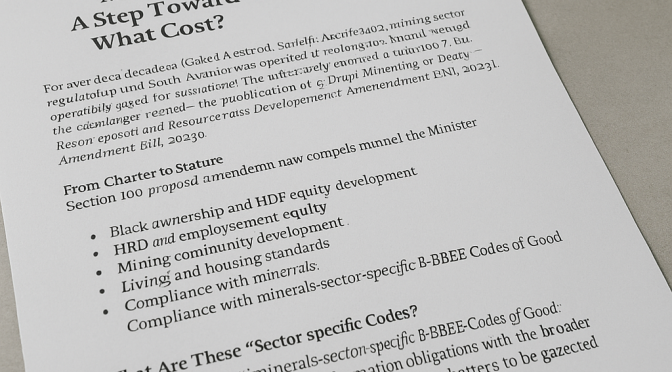I thought I’d share some quick take‑aways from recent visits to two different DMPR offices in separate provinces, as well as a stop at the municipality. It was interesting to see just how differently the policies get applied on the ground.
For example:
- At one office, school infrastructure was not recognised as LED, while the other office considered it a good fit.
- At both offices NEMA was not even mentioned during consultations. Yet NEMA is prominent in the proposed amended mining legislation, and only a footnote in the older regulations. From what I’ve seen, it tends to be the very large, often listed mines that go down the full NEMA route. It shouldn’t be underestimated though, and having an early meeting with the DMPR office is definitely the way to go.
- On AET, one office didn’t see it as essential, leaning instead toward skills training or fencing projects. The other office kept AET in play, especially for external communities. For fully employed staff it was viewed as less critical, since most workers already hold a matric and there’s an oversupply of labour candidates with mines tending to hire the highest qualified workers.
- Bursaries were another contrast: one office preferred they stay within labour‑sending areas, the other encouraged opening them up across the province. What is interesting is that whether I meet with the municipality or the DMPR, bursaries are considered immensely valuable, and I would almost go underweight on AET and overweight on bursaries.
- Employment equity rules also differed, with one side using the new Act and the other still sticking to the Mining Charter 2018 wording. In practice though, the difference between the MC 2018 provisions and the new Employment Equity Act is very small.
- And while one office cut politicians out of LED project decisions, the other was adamant they must be consulted.
Neither office paid much attention to procurement, still falling back on 2014 Charter guidelines. I find this interesting because with hindsight the 2014 targets are quite low and lag behind the more recent generic BBBEE codes—rather ironic since mining was once the leader in developing the BEE scorecard.
Our 110‑page SLP template report, however, was well received in both places. It follows each regulatory heading in separate paragraphs to make sure every aspect is covered. The template sets out forms and tables in the way the DMPR likes to see them—practical, detailed, and aligned with their own guidelines. They want concrete commitments, even if those change later. For example, simply stating a target number for learnerships isn’t enough; one has to list the actual titles—millwright, blaster, boilermaker, and so on.
At the municipality, they stressed that the IDPs don’t list many ward‑level projects—often the rural wards get left out because of their remoteness and the more urgent priorities in the larger populated areas—so they expect the mine to come up with ideas. They liked the mix of social entrepreneurship plus infrastructure development. For one client, we’re already in round four of negotiations with both the DMPR and municipality to get a tree nursery approved. It’s a project I proposed, and beyond jobs it could generate carbon credits too—but it’s taken persistence to keep it alive.
These little differences highlight why outside guidance is useful. Knowing where interpretations split and how to steer through them saves time, avoids costly delays, and keeps projects both compliant and meaningful for the community.
Best,
Gerrie


